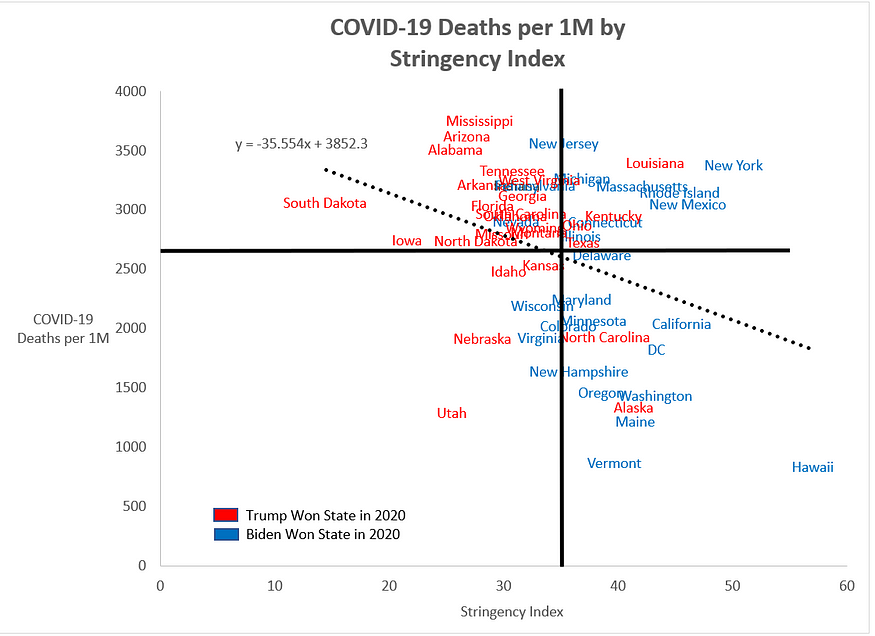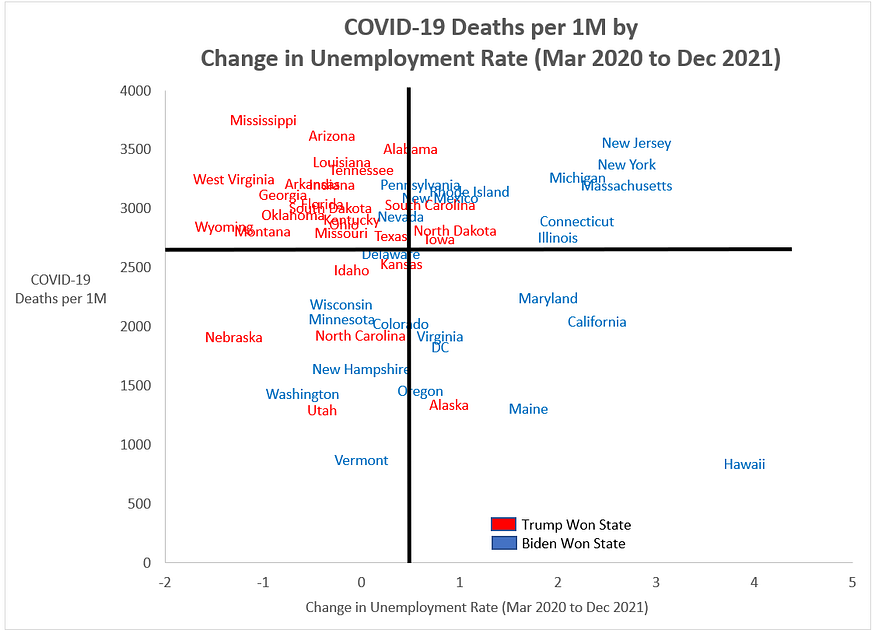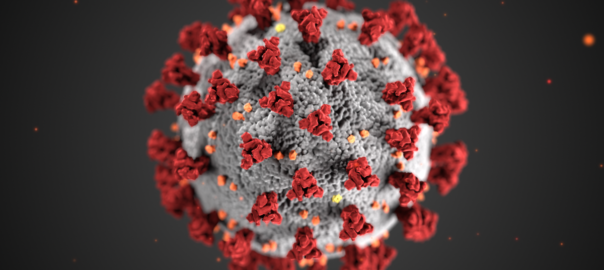By Kent R. Kroeger (Source: NuQum.com; February 24, 2022)
In a previous essay, I shared a statistical model that partitioned variation in COVID-19 death rates across the 50 U.S. states (plus the District of Columbia) based on a variety of factors, including the stringency of state COVID-19 policies, vaccination rates, preexisting economic conditions, the availability of nurses in nursing homes, and the healthiness of the state’s population.
The primary conclusion was that stringent state-level COVID-19 policies had a discernable association with death rates, all else equal, but that preexisting levels and changes in a state’s unemployment rate had a comparable, if not stronger, relationship.
Lockdowns and other COVID-19 mitigation policies worked in minimizing COVID-19 death rates, but their positive impact was betrayed somewhat by the extent to which they harmed a state’s economy and employment levels.
In the midst of a worldwide virus pandemic, unemployment and economic distress can kill just as ruthlessly as a virus.
It is far too easy in our highly partisan political environment to see the world in oversimplified motifs such as: Democrats trust the science and Republicans deny it.
That lazy conceit is not only inaccurate, it is unconstructive to a public debate on how to handle a viral pandemic.
Throughout this public health crisis, the science has been understandably tentative, sometimes ambiguous and too often nakedly political.
Wear masks. Don’t wear masks. Just kidding…wear masks…properly…but they must be the good ones.
People exposed to COVID-positive individuals should quarantine for 10 days…make that 5 days.
If you are vaccinated, you don’t need to wear a mask…scratch that…yes, you do.
Getting the virus doesn’t produce a natural immunity comparable to the vaccines…or, maybe, it does.
And why would anyone expect the public policies issued in this environment to be consistent and coherent?
The reality is that the science on COVID-19 is evolving along with the virus itself. Science is never perfect. It makes mistakes. Politicians and media personalities can lecture others to “trust the science,” but actual scientists don’t have that luxury. They can’t trust the science. By training, it is their job to always question it. Poke it. Prod it. Unrelenting skepticism is a virtue in their line of work, not a vice.
More crucially, science doesn’t operate in a vacuum. When science is translated into policy — as it has been throughout the COVID-19 pandemic — it is a political act. Scientists can’t be expected to understand the social implications of their research findings and recommendations — which is why, in our system of government, we purposefully put elected representatives between the scientists and their policy recommendations. The U.S. is a representative democracy, not a technocracy — and for good reason, policymaking requires a wholistic view of issues that few scientists possess.
In an article for the American Institute for Economic Research, economist Jon Murphy outlined how the disconnected perspectives between elected leaders and scientists explain the cascade of mistakes and contradictions that regrettably define many of the policy decisions made during the COVID-19 pandemic:
“Experts are just like us. They are experts in their specific fields, but not beyond them. The problem with a pandemic is that it is not simply a medical phenomenon. There are economic issues at play, political issues at play, mental health issues, educational issues, etc. Dr. Fauci may be a brilliant immunologist, but he is no economist.”
State policies mattered during the COVID-19 pandemic
At the beginning of the pandemic, World Health Organization Director General Tedros Adhanom Ghebreyesus warned that “this virus does not respect borders.”
Two years later, he has been proven right — no jurisdiction has been spared.
But a handful of Republican governors confused the easy transmissibility of the coronavirus with the belief that strict, broadly-targeted statewide policies could not contain the virus’ spread and reduce the number of deaths. [Early in the pandemic, I believed the same thing.]
They (including me) were dead wrong.
However, these same governors rightfully recognized that strict COVID-19 lockdowns also cause significant economic harm, particularly to people who were financially vulnerable heading into the pandemic. Florida Governor Ron DeSantis repeatedly resisted lockdown policies because, in his words, they would “hurt families who can’t afford to shelter in place for six weeks.”
Was he wrong?
The answer is complicated. Still, I prefer simple displays of data whenever possible.
So, my first stab at answering the question is looking at a basic bivariate plot of state-level COVID-19 deaths per capita versus the average daily stringency of state-level COVID-19 policies from March 1, 2020 to December 1, 2021.
Figure 1 is that initial plot…
Figure 1: COVID-19 deaths per 1 million people by the OxCGRT Policy Stringency Index (March 2020 to December 2021)

It is evident from Figure 1 that Republican states disproportionately pursued less stringent COVID-19 policies and suffered disproportionately higher COVID-19 deaths per capita.
Mississippi, Arizona, Alabama, and South Dakota are not COVID-19 success stories. They largely ignored the virus and the consequences can be measured in deaths among their residents. In contrast, Hawaii, Vermont, Maine, Alaska, Oregon and Washington seemed to do pretty well. They instituted strict COVID-19 policies which resulted in significantly fewer deaths per capita.
But Figure 1 does not consider the economic impact of COVID-19.
Figure 2 plots COVID-19 deaths per capita at the state-level versus the change in unemployment.
Figure 2: COVID-19 deaths per 1 million people by the Change in Unemployment Rate (March 2020 to December 2021)

Now we have a better picture as to which states performed better than others during this pandemic.
Figure 2 is quadrant analysis. The upper-left-hand quadrant (high COVID-19 death rates and small changes in the unemployment rate) and the lower-right-hand quadrant (low COVID-19 death rates and large increases in the unemployment rate) are non-exemplary cases. These states either chose to minimize the pandemic and suffered disproportionately high numbers of deaths, or chose to shutdown their economies and suffered economically.
The other two quadrants separate out the genuine failures and leaders of the COVID-19 pandemic. In the failure category are states like New York, New Jersey, Michigan and Massachusetts — all “Blue” states — who suffered high COVID-19 deaths rates and large increases in unemployment.
Their COVID-19 policies failed by any objective measure.
On the positive side are states that minimized COVID-19 deaths rates while keeping their economies relatively strong. Those states include Vermont, Utah, Washington, New Hampshire, Nebraska, North Carolina, Minnesota, and Wisconsin — three of which are “Trump” states.
It is convenient to assume “Blue” states outperformed “Red” states during the COVID-19 pandemic. If COVID-19 death rates are your preferred metric, they did. But when considering the impact of COVID-19 policies on state economies, the biggest failures were, by far, some of the biggest “Blue” states and a meaningful percentage of the successful states were “Red.”
Mississippi and Arizona kept their economies open (and successful) during the pandemic and paid a significant price in human lives.
In contrast, Hawaii, Maine, California and Maryland shut their economies down during the pandemic and saved many lives in the process.
Who was right and who was wrong?
In the end, voters will decide which states pursued the best COVID-19 policies…but don’t assume voters will choose human lives over economic growth.
- K.R.K.
Send comments to kroeger98@yahoo.com
